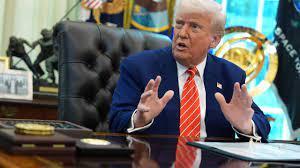Grokipedia Launches as a Next-Gen Knowledge Platform Powered by AI
Grokipedia debuts as an AI-powered knowledge platform that combines community-driven insight with real-time AI learning.

In a bold move to reassert U.S. dominance in global artificial intelligence, the Trump administration has unveiled a sweeping AI export strategy aimed at loosening domestic restrictions and boosting international trade of American AI systems. The White House plan—positioned as a geopolitical counterweight to China’s expanding AI footprint—marks a sharp shift from the Biden-era approach to AI regulation.
“We’re not just leading in AI—we’re making sure the world uses American AI,” President Trump declared during a press briefing, framing the new strategy as key to “winning” the AI arms race.
Table of contents [Show]
At the heart of the plan is a push for “full-stack” export packages that bundle AI hardware, software, and cloud services for trusted allies. The policy aims to:
Countries like Japan, the U.K., South Korea, Nigeria, and India are expected to be early targets for expanded U.S. AI exports.
The AI industrial blueprint outlines over 90 recommendations, including:
Critics say the strategy rolls back hard-won guardrails around AI misuse and risk management. But Trump officials argue that such constraints only slow U.S. leadership while China aggressively scales its AI exports without comparable controls.
While not explicitly naming China in every line, the strategy leaves little doubt about its intent. The plan includes direct comparisons to Chinese export models and criticizes Beijing’s influence in regions like Africa and Southeast Asia through low-cost AI deployments.
“We cannot let authoritarian AI become the global standard,” said a senior White House advisor. “This is how we set the rules—by getting there first.”
One of the plan’s key structural changes is the push for a unified federal approach to AI oversight, eliminating the patchwork of state-level rules that currently create compliance friction for developers and exporters. The proposal calls for:
This aligns with the broader Trump-era push for deregulation in emerging tech sectors, favoring speed and global competitiveness over precautionary frameworks.
The tech industry’s initial reaction is cautiously optimistic. Many AI developers and defense contractors welcome the plan’s potential to unlock international markets and simplify domestic compliance.
But civil society groups and AI ethics organizations are raising red flags.
“We risk exporting untested, unaccountable AI to countries without proper safeguards,” said Dr. Lila Jamison, director at the Center for Ethical Tech. “Removing Biden’s diffusion limits opens the door to unintended consequences.”
This U.S. pivot may force allied governments—and rivals—to revisit their own AI trade policies. Expect a domino effect in Europe, Japan, and even parts of the Global South as they weigh aligning with U.S. tech standards or maintaining stricter EU-style guardrails.
Trump’s AI export strategy adds fuel to the already-heated global race for AI dominance. With bold rhetoric, deregulation, and a clear anti-China stance, the U.S. is placing its chips on speed, scale, and strategic alliances.
Whether this approach accelerates American AI leadership or risks backlash from regulatory bodies remains to be seen. One thing is certain: the next era of AI won’t just be written in code—it’ll be written in policy.
Grokipedia debuts as an AI-powered knowledge platform that combines community-driven insight with real-time AI learning.
President Donald Trump has officially pardoned Binance founder Changpeng “CZ” Zhao, marking a major shift in U.S. crypto policy and reigniting optimism across the global digital asset market.
Nvidia is putting $5B into Intel in a strategic alliance to design next-gen chips for AI and PCs. Close CPU-GPU integration promised, but foundry work excluded.
